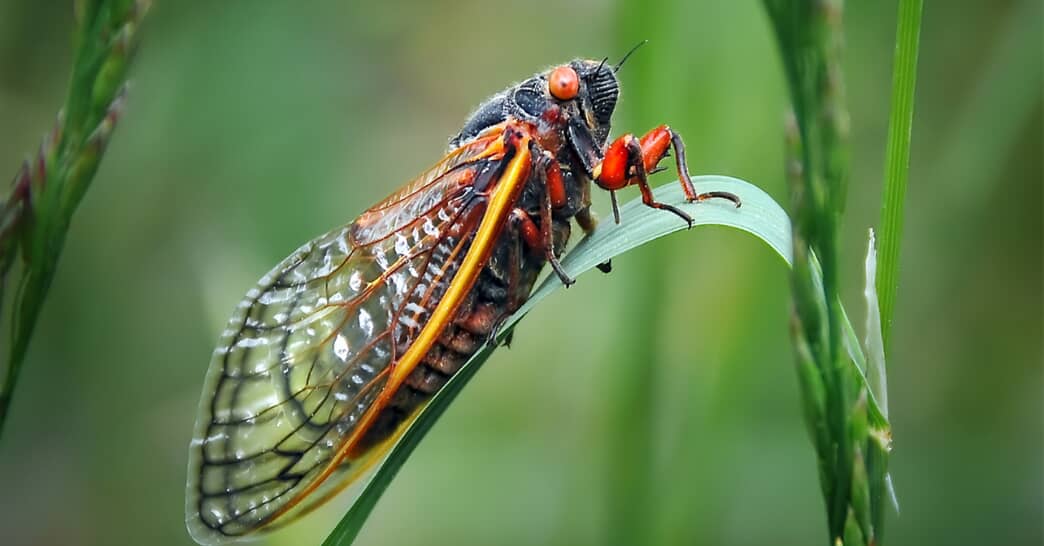Largest Swarm of Cicadas to Surface in 2021

Love them or hate them, we can’t avoid them. The largest brood of cicadas is set to emerge from their 17-year slumber this May. According to experts, there could be as many as 1.5 million cicadas per acre in Brood X hotspots such as Georgia, Northern Virginia, Western Ohio, Southern Pennsylvania, and most of Indiana and Maryland.
Annual Cicadas vs Periodical Cicadas
Periodical cicadas differ from the cicadas many of us are familiar with. The green-bodied cicadas that pop up every year are known as annual cicadas. Annual cicadas have a two-year lifespan and appear every summer.
Periodical cicadas are easily discernible from their annual cousins. They have black bodies, bright red eyes, and clear wings. The wingspan of a fully grown adult can reach three to four inches across.
Is Brood X Dangerous?
Cicadas don’t pose any direct threat to humans. They can’t bite or sting like wasps, but their feet are bristly and can prick your skin while held. They can, however, cause harm to saplings and fruit trees.
Female cicadas lay their eggs in small, pencil-thin branches of trees. This isn’t a problem for mature trees, but for saplings and more delicate fruit trees, the weight of the eggs could result in twigs or young branches falling off. Still, cicadas are not seen as any particular threat to plants in general.
Lifecycle of a Cicada
Cicadas live longer than any other insect. Brood X was born and went underground in 2004, during the last periodical cicada emergence. Periodical cicadas are ‘developmentally synchronized’ — they develop underground for 13 to 17 years before emerging for 4 to 6 weeks to reproduce.
Male cicadas will live about two to four weeks, giving them just enough time to attract a mate and reproduce. Female cicadas lay eggs in thin branches of trees. One female cicada can lay up to 600 eggs. Somewhere between six to 10 weeks later, the eggs hatch, and ‘nymphs’ emerge. The nymphs drop to the ground and burrow into the ground, where they feed on nutrients from tree and shrub roots. 17 years later, the cycle starts again as nymphs emerge and mature into adult cicadas before beginning reproduction.
Cicadas are expected to surface around May, but they can emerge anytime after the soil temperature has reached 65 degrees. Depending on the region, Brood X could begin to surface as early as late April and could stick around as late as mid-July.
How To Prepare for Brood X
Even though cicadas don’t harm you, your home, and most plants, many homeowners may want to take precautions against a swarm of large insects. Here are some simple ways to best keep Brood X at bay:
- Hold off on planting. Hold off on adding new plants and trees until fall, when the swarm has died off. If you’ve already planted for the season, covering your plants should protect them.
- Protect newer plants. Younger trees and saplings are the most at-risk for destruction during the cicadas’ reproductive cycle. Install some mesh or cheesecloth around the trunk of your trees to stop cicadas from climbing up to lay their eggs.
- Use your hose. If you want to get rid of cicadas around your home, spray them with a garden hose!
Do I need pest control for cicadas?
Typically, pest control solutions are best for bugs and insects with predictable behaviors and movements. Using store-bought insecticides in your yard can actually harm the local wildlife that use cicadas as a food source.
Cicadas can be loud and scary looking, but they’re harmless. If any get in your home, simply cover them and take them outside. Contact Accel Pest and Termite Control for your pest control needs this summer! We serve Virginia Beach and North Carolina and have a sister branch serving Northeast Ohio. Contact our team at (877) 716-7522 with questions or to learn how we can help you tackle your pest problems!
